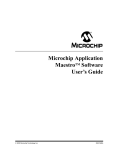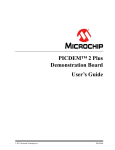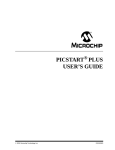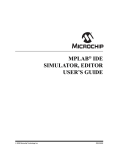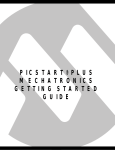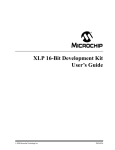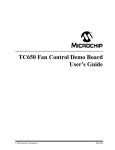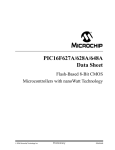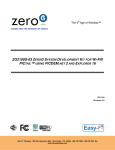Download Arizona Picdem 17 User`s guide
Transcript
PICDEMTM 4 User’s Guide 2003 Microchip Technology Inc. DS51337A Note the following details of the code protection feature on Microchip devices: • Microchip products meet the specification contained in their particular Microchip Data Sheet. • Microchip believes that its family of products is one of the most secure families of its kind on the market today, when used in the intended manner and under normal conditions. • There are dishonest and possibly illegal methods used to breach the code protection feature. All of these methods, to our knowledge, require using the Microchip products in a manner outside the operating specifications contained in Microchip's Data Sheets. Most likely, the person doing so is engaged in theft of intellectual property. • Microchip is willing to work with the customer who is concerned about the integrity of their code. • Neither Microchip nor any other semiconductor manufacturer can guarantee the security of their code. Code protection does not mean that we are guaranteeing the product as “unbreakable.” Code protection is constantly evolving. We at Microchip are committed to continuously improving the code protection features of our products. Attempts to break microchip’s code protection feature may be a violation of the Digital Millennium Copyright Act. If such acts allow unauthorized access to your software or other copyrighted work, you may have a right to sue for relief under that Act. Information contained in this publication regarding device applications and the like is intended through suggestion only and may be superseded by updates. It is your responsibility to ensure that your application meets with your specifications. No representation or warranty is given and no liability is assumed by Microchip Technology Incorporated with respect to the accuracy or use of such information, or infringement of patents or other intellectual property rights arising from such use or otherwise. Use of Microchip’s products as critical components in life support systems is not authorized except with express written approval by Microchip. No licenses are conveyed, implicitly or otherwise, under any intellectual property rights. Trademarks The Microchip name and logo, the Microchip logo, KEELOQ, MPLAB, PIC, PICmicro, PICSTART, PRO MATE and PowerSmart are registered trademarks of Microchip Technology Incorporated in the U.S.A. and other countries. FilterLab, microID, MXDEV, MXLAB, PICMASTER, SEEVAL and The Embedded Control Solutions Company are registered trademarks of Microchip Technology Incorporated in the U.S.A. Accuron, Application Maestro, dsPIC, dsPICDEM, dsPICDEM.net, ECONOMONITOR, FanSense, FlexROM, fuzzyLAB, In-Circuit Serial Programming, ICSP, ICEPIC, microPort, Migratable Memory, MPASM, MPLIB, MPLINK, MPSIM, PICC, PICkit, PICDEM, PICDEM.net, PowerCal, PowerInfo, PowerMate, PowerTool, rfLAB, rfPIC, Select Mode, SmartSensor, SmartShunt, SmartTel and Total Endurance are trademarks of Microchip Technology Incorporated in the U.S.A. and other countries. Serialized Quick Turn Programming (SQTP) is a service mark of Microchip Technology Incorporated in the U.S.A. All other trademarks mentioned herein are property of their respective companies. © 2003, Microchip Technology Incorporated, Printed in the U.S.A., All Rights Reserved. Printed on recycled paper. Microchip received QS-9000 quality system certification for its worldwide headquarters, design and wafer fabrication facilities in Chandler and Tempe, Arizona in July 1999 and Mountain View, California in March 2002. The Company’s quality system processes and procedures are QS-9000 compliant for its PICmicro® 8-bit MCUs, KEELOQ® code hopping devices, Serial EEPROMs, microperipherals, non-volatile memory and analog products. In addition, Microchip’s quality system for the design and manufacture of development systems is ISO 9001 certified. DS51337A - page ii 2003 Microchip Technology Inc. PICDEM 4 User’s Guide Table of Contents Chapter 1. Introduction 1.1 Welcome ......................................................................................... 1 1.2 PICDEM 4 Demonstration Board .................................................... 2 1.3 Sample Devices .............................................................................. 3 1.4 Sample Programs ........................................................................... 3 1.5 PICDEM 4 User’s Guide ................................................................. 3 1.6 Reference Documents .................................................................... 3 Chapter 2. Getting Started 2.1 PICDEM 4 as a Stand-Alone Board – Preprogrammed Device .................................................................. 5 2.2 PICDEM 4 Used with an In-Circuit Emulator or In-Circuit Debugger ......................................................................... 6 Chapter 3. Tutorial 3.1 Tutorial Firmware Operation ........................................................... 7 3.2 Source Code and Application Notes ............................................... 8 2003 Microchip Technology Inc. DS51337A-page iii PICDEM 4 User’s Guide Appendix A. Hardware Detail A.1 Processor Sockets ........................................................................11 A.2 LED DISPLAY ...............................................................................11 A.3 Power Supply ................................................................................11 A.4 RS-232 Serial Port ........................................................................11 A.5 Switches ........................................................................................12 A.6 Oscillator Options ..........................................................................12 A.7 Analog Input ..................................................................................12 A.8 ICD Connector ..............................................................................12 A.9 Serial EEPROM ............................................................................13 A.10 Motor .............................................................................................13 A.11 LIN .................................................................................................16 A.12 Supercapacitor ..............................................................................17 A.13 Real-Time Clock ............................................................................18 A.14 LCD Display ..................................................................................18 A.15 Device Configuration Overview .....................................................19 A.16 Board Layout and Schematics ......................................................20 Index .......................................................................................................... 23 Worldwide Sales and Service.................................................................. 24 DS51337A-page iv 2003 Microchip Technology Inc. PICDEM 4 User’s Guide Chapter 1. Introduction 1.1 WELCOME Thank you for purchasing the PICDEM 4 demonstration board from Microchip Technology Incorporated. The PICDEM 4 demonstrates the capabilities of the 8-, 14-, and 18-pin PIC16XXXX and PIC18XXXX devices. The PICDEM 4 can be used stand-alone with a programmed part, with an In-Circuit Emulator (e.g., MPLAB® ICE), or with an In-Circuit Debugger (e.g., MPLAB ICD 2). Sample programs are provided to demonstrate the unique features of the supported devices. The PICDEM 4 Kit comes with the following: 1. PICDEM 4 Demonstration Board (Figure 1-1) 2. Sample Devices 3. CD-ROM, which contains: a) Sample Programs b) PICDEM 4 Demonstration Board User’s Guide c) Application Notes If you are missing any part of the kit, please contact your nearest Microchip sales office listed in the back of this publication for help. 2003 Microchip Technology Inc. DS51337A-page 1 PICDEM 4 User’s Guide 1.2 PICDEM 4 DEMONSTRATION BOARD The PICDEM 4 demonstration board has the following hardware features: 1. 8-, 14- and 18-pin DIP sockets. (Although 3 sockets are provided, only one device may be used at a time.) 2. On-board +5V regulator for direct input from 9V, 100 mA AC/DC wall adapter or 9V battery, or hooks for a +5V, 100 mA regulated DC supply. 3. RS-232 connection and associated hardware for direct connection to RS-232 interface. 4. In-Circuit Debugger (ICD) connector. 5. Four 5 kΩ pots for devices with analog inputs and comparators. 6. Three push button switches for external stimulus and RESET. 7. Green power-on indicator LED. 8. Eight red LEDs connected to PORTA and PORTB. 9. Jumpers J21 and J22 to disconnect LEDs from PORTA and PORTB. 10. Unpopulated holes provided for crystal connection. 11. 32.768 kHz crystal for Timer1 Real-Time Clock operation. 12. Jumper J14 to disconnect on-board RC oscillator (R20 and C15, approx. 2 MHz). 13. Unpopulated holes for EEPROM. 14. 2 x 16 LCD display. 15. Prototype area for user hardware. 16. PIC16LF72 I/O expander. 17. Supercapacitor circuitry. 18. Unpopulated holes for a LIN transceiver. 19. Unpopulated holes for a motor driver. FIGURE 1-1: PICDEM 4 HARDWARE 7 17 16 5 14 2 18 8 3 9 4 10 12 19 11 1 15 6 DS51337A-page 2 13 2003 Microchip Technology Inc. Introduction 1.3 SAMPLE DEVICES Two FLASH devices are included. The device types may change, but will generally include PIC16XXXX and PIC18XXXX 18-pin DIP devices. 1.4 SAMPLE PROGRAMS The PICDEM 4 Kit includes a CD-ROM with sample demonstration programs. These programs may be used with the included sample devices, with an In-Circuit Emulator (ICE), or with an In-Circuit Debugger (ICD). For each type of device (PIC16XXXX or PIC18XXXX), demo source code (several ASM files) and compiled code (one HEX file) are provided. 1.5 PICDEM 4 USER’S GUIDE This document describes the PICDEM 4 demonstration board, tutorial and demonstration software. Detailed information on individual microcontrollers may be found in the device’s respective data sheet. Detailed information on In-Circuit Emulator (ICE) or In-Circuit Debugger (ICD) systems may be found in the respective tool’s user’s guide. Chapter 1: Introduction – This chapter introduces the PICDEM 4 and provides a brief description of the hardware. Chapter 2: Getting Started – This chapter goes through a basic step-by-step process for getting your PICDEM 4 up and running as a stand-alone board, or with an ICE or ICD. Chapter 3: Tutorial – This chapter provides a detailed description of the tutorial program. Appendix A: Hardware Detail – This appendix describes in detail the hardware of the PICDEM 4 board. 1.6 REFERENCE DOCUMENTS Reference Documents may be obtained by contacting your nearest Microchip sales office (listed in the back of this document), or by download from the Microchip web site (www.microchip.com). • Technical Library CD-ROM (DS00161) or individual data sheets: - PIC16F627A/628A/648A Data Sheet (DS40044) - PIC18F1220/1320 Data Sheet (DS39605) - PICmicroTM Mid-Range MCU Family Reference Manual (DS33023) - PICmicro® 18C MCU Family Reference Manual (DS39500) • MPLAB® IDE Simulator, Editor User’s Guide (DS51025) • MPASM User’s Guide with MPLINK and MPLIB (DS33014) • PRO MATE® II User’s Guide (DS30082) • PICSTART® Plus User’s Guide (DS51028) • MPLAB® ICE Emulator User’s Guide (DS51159) • MPLAB® ICD 2 In-Circuit Debugger Quick Start Guide (DS51268) • Microchip Third Party Guide (DS00104) 2003 Microchip Technology Inc. DS51337A-page 3 PICDEM 4 User’s Guide NOTES: DS51337A-page 4 2003 Microchip Technology Inc. PICDEM 4 User’s Guide Chapter 2. Getting Started The PICDEM 4 may be used as a stand-alone board with a preprogrammed device, with an In-Circuit Emulator (ICE), or with an In-Circuit Debugger (ICD). For a list of PICmicro microcontroller compatible ICEs or ICDs, please refer to the Development Systems Ordering Guide or the Microchip Third Party Guide. 2.1 PICDEM 4 AS A STAND-ALONE BOARD – PREPROGRAMMED DEVICE The PICDEM 4 may be demonstrated immediately by following the steps listed below: • Place the preprogrammed sample device in the appropriate socket on the PICDEM 4 board. • Apply power to the PICDEM 4. For information on acceptable power sources, see Appendix A. Note: In the event that the preprogrammed PICDEM 4 demonstration board does not operate, check the following conditions: - J8/J10 must be connected for the appropriate device - J3, J4, J7, J9, and J24 - J27 must be ON - J23 and J28 must be OFF The status of all other jumpers will not affect the preprogrammed demonstration. To reprogram the sample device, the following will be necessary: 1. Program source code. User source code may be used to program the device or, if this has previously been done, the sample program may be restored from the file on the included CD-ROM. 2. An assembler, such as MPASMTM assembler (available with MPLAB IDE), or a compiler, such as MPLAB C18 (PIC18XXXX devices only). Source code must be assembled or compiled into a HEX file before it can be programmed into the device. Microchip Technology’s MPASM assembler or MPLAB C18 C compiler may be used. Both are compatible with MPLAB IDE; however, other assemblers/compilers may be used. For a list of these PICmicro MCU compatible language tools, please refer to the Microchip Third Party Guide. 3. A device programmer, such as PRO MATE II, PICSTART Plus, or MPLAB ICD 2 (programmer functionality available with MPLAB IDE v6.00 or greater). Once the sample program is in HEX file format, a programmer may be used to program a FLASH device. Microchip Technology’s PRO MATE II device programmer, PICSTART Plus development programmer, or MPLAB ICD 2 may be used. All are compatible with MPLAB IDE. However, other programmers may be used. For a list of these PICmicro MCU compatible programmers, please refer to the Microchip Third Party Guide. If the code protection bit(s) have not been programmed, the on-chip program memory can be read out for verification purposes. 2003 Microchip Technology Inc. DS51337A-page 5 PICDEM 4 User’s Guide 2.2 PICDEM 4 USED WITH AN IN-CIRCUIT EMULATOR OR IN-CIRCUIT DEBUGGER To use PICDEM 4 with an In-Circuit Emulator (ICE) or In-Circuit Debugger (ICD), refer to the tool’s user’s guide for instructions on how to power-up and configure the ICE/ICD, as well as how to connect to target boards (e.g., Figure 2-1). FIGURE 2-1: PICDEM 4 CONNECTED TO MPLAB ICD 2 USING USB Configure the PICDEM 4 for the desired oscillator as described in Table 2-1. Refer to the ICE/ICD user’s guide for any oscillator configuration requirements. TABLE 2-1: OSCILLATOR SELECTION Oscillator Selection on PICDEM 4 DS51337A-page 6 Modification on PICDEM 4 RC J14 ON, Y3 empty, Y1 empty Crystal J14 OFF, Y1 empty, crystal in Y3, caps in C15 and C16 Canned Oscillator J14 OFF, oscillator in Y1 (Y3, C15, C16 empty) Device Internal Oscillator J14 OFF, Y1 empty, Y3 empty Resonator - no internal caps J14 OFF, Y1 empty, resonator in Y3, caps in C15 and C16 Resonator - with internal caps J14 OFF, Y1 empty, resonator in Y3, C15 and C16 empty 2003 Microchip Technology Inc. PICDEM 4 User’s Guide Chapter 3. Tutorial The tutorial program is preprogrammed into the sample device (for example, p16PDEM4_Demo.hex for a PIC16XXXX device and p18PDEM4_Demo.hex for a PIC18XXXX device). Also, this program is on the included CD-ROM program disk for user reference (i.e., if the sample device has been reprogrammed with another program, the tutorial may be reprogrammed into the device). For detailed information on the PICDEM 4 hardware, please refer to Appendix A. 3.1 TUTORIAL FIRMWARE OPERATION The PIC18F tutorial firmware is made up of two components, which are individually displayed on the LCD. The PIC® microcontroller’s internal RC oscillator is used as the system clock source. 1. Voltmeter This mode uses the A/D module to measure the voltage of the R33 pot and displays a voltage between 0.00V and 5.00V on the LCD. Voltage is continually updated until the mode is exited by pressing SW3 (RB0). 2. Clock Once this mode is entered from the main menu, a real-time clock will start counting from 00:00:00. The Timer1 module and a 32 kHz clock crystal is used to establish a Real-Time Clock. By pressing SW1, the clock time can be set to the user's preference. After SW1 has been pressed, the cursor will flash over the hours digits. Press SW1 and the cursor will now flash over the minutes digits. SW3 is used to increment hours and minutes whenever the cursor is flashing over either. After the minutes have been set, press SW1 and the time will be set and the LCD is returned to an active clock display. The PIC16F tutorial firmware is made up of one component, which uses the comparator module and potentiometers R12, R15, R33, and R34. Turning the potentiometers will vary the voltages to the PIC16 inputs, thereby changing the results of the comparator outputs. The LCD will be used for displaying these results. 2003 Microchip Technology Inc. DS51337A-page 7 PICDEM 4 User’s Guide FIGURE 3-1: PIC18F TUTORIAL PROGRAM FLOW CHART Power-up "Microchip PICDEM 4" Voltmeter SW1 = Next SW3 = Now SW3 SW1 Real-Time Clock SW1 = Next SW3 = Now Volts = 1.93V SW3 = Exit Test SW3 SW3 SW1 00:00:00 SW1 = Set SW3 = Menu SW1 SW3 00:00:00 SW1 = -> SW3 = ++ SW1 (2x) 3.2 SOURCE CODE AND APPLICATION NOTES In addition to the assembled tutorial programs (HEX files), source code used to create these HEX files is included on the PICDEM 4 CD-ROM. Both source code and related HEX file are found in device specific directories. Application Notes are also included on the CD-ROM for additional examples of use. For information on how to reprogram the device with new or modified code, or how to restore the tutorial program, please see Section 2.1. DS51337A-page 8 2003 Microchip Technology Inc. PICDEM 4 User’s Guide Appendix A. Hardware Detail The PICDEM 4 hardware is uncomplicated and is intended to illustrate the ease of use of various PICmicro MCUs. The PICDEM 4 features the following hardware elements. Note: 2003 Microchip Technology Inc. Many of the following hardware sections will require specific demo board jumper configurations. If a jumper is not listed in a particular section, then that jumper has no effect on the circuitry within the hardware section you are working. Figure A-1 shows a diagram of the PICDEM 4 silkscreen with all necessary jumpers highlighted. Also, refer to the schematic for circuit connections. DS51337A-page 9 PICDEM 4 User’s Guide PICDEM 4 DEMONSTRATION BOARD PARTS LAYOUT (SILKSCREEN) J9 J7 J14 J13 J12 J17 J11 J16 J18 J4 J23 J3 J28 J19 J20 J24 J25 J26 J27 J8 J10 J21 J15 J22 FIGURE A-1: DS51337A-page 10 2003 Microchip Technology Inc. Hardware Detail A.1 PROCESSOR SOCKETS Although three sockets are provided, only one device may be used at a time. • 8- or 14-pin socket (U5) used for 8- or 14-pin devices (8-pin devices are inserted in the upper 8 pins of U5) • 18-pin PIC16 socket (U7) • 18-pin PIC18 socket (U8) A.2 LED DISPLAY Eight red LEDs are connected to PORTA and PORTB of U7 and U8, while five of the eight LEDs are connected to U5. PORTA and PORTB pins are set high to light the LEDs. These LEDs may be disconnected from PORTA and PORTB by removing jumpers J21 and J22. One green LED is provided to determine whether there is power to the PICDEM 4 board (LED on) or not (LED off). A.3 POWER SUPPLY There are three ways to supply power to PICDEM 4: • A 9V battery can be plugged into J2. • A 9V, 100 mA unregulated AC or DC supply can be plugged into J1. A power supply can be purchased through Microchip, Part # AC162039. • A +5V, 100 mA regulated DC supply can be connected to the hooks provided. Note 1: 2: There are two jumpers (J3 and J4) associated with the power supply circuit. These jumpers must be on for all functions, with the exception of the Supercapacitor Circuit. Refer to Section A.12 “Supercapacitor” for further details. The PICDEM 4 kit does not include a power supply. MPLAB ICE 2000 users have a regulated +5V power supply available in the logic probe connector and can easily connect to the hooks on PICDEM 4 (Red probe to +5V and Black probe to GND). MPLAB ICD 2 users may use the ICD to power the target board to 5V, up to 200 mA, if the MPLAB ICD 2 is connected to the PC with a serial cable. A.4 RS-232 SERIAL PORT An RS-232 level shifting IC has been provided with all necessary hardware to support connection of an RS-232 host through the DB9 connector. The port is configured as DCE, and can be connected to a PC using a straight through cable. The PIC16/PIC18 RX and TX pins are tied to the RX and TX lines of the LT1280ACN. Unlike previous demo boards, the RS-232 chip has an ON/OFF pin which is connected to I/O pin RB3. For RS-232 operation, these jumpers must be configured as follows: PIC16 • J18/19 - Upper two pins ON • J20 - OFF (if populated) PIC18 • J18/19 - Lower two pins ON 2003 Microchip Technology Inc. DS51337A-page 11 PICDEM 4 User’s Guide A.5 SWITCHES Three switches provide the following functions: • S1 - Active low switch connected to RA4 • S2 - MCLR to hard reset the processor • S3 - Active low switch connected to RB0 Switch S2 has a debounce capacitor, whereas S1 and S3 do not, allowing the user to investigate debounce techniques. When pressed, the switches are grounded; when idle, they are pulled high (+5V). A.6 OSCILLATOR OPTIONS • RC oscillator (2 MHz approximately) supplied. This oscillator may be disabled by removing jumper J14. • Pads provided for user furnished crystal/resonator and two capacitors (Y3). • Socket provided for a canned oscillator (Y1). • 32.768 kHz (watch type) crystal for Timer1 (Y2). This oscillator can be disabled by removing jumpers J7 and J9. A.7 ANALOG INPUT There are four 5 kΩ potentiometers (R12, R15, R33, R34) on the PICDEM 4 board. These are all connected to PORTA (RA0-RA3), and can be adjusted from VSS to VDD to provide an analog input to the devices with an A/D or Comparator module. Potentiometers R12, R15, R33, and R34 all have individual jumpers. For a potentiometer to function, its specific jumper must be on. The jumper removed will allow for other I/O functions to take place. For all of the potentiometers to be functional, these jumpers must be configured as follows: • • • • • J22 - OFF (PORTA LEDs) J24 - ON J25 - ON If J26 is ON, then J23 is OFF If J27 is ON, then J28 is OFF The above conditions will enable all potentiometers. A.8 ICD CONNECTOR By way of the modular connector (J5), the MPLAB ICD 2 can be connected for low cost debugging. The ICD connector utilizes RB6 and RB7 of the microcontroller for in-circuit debugging. For ICD operation, the Real-time Clock connections to the microcontroller must be disabled. For ICD operation, these jumpers must be configured as follows: • J7 - OFF (RTC) • J9 - OFF (RTC) • J21 - OFF (PORTB LEDs) DS51337A-page 12 2003 Microchip Technology Inc. Hardware Detail A.9 SERIAL EEPROM For EEPROM operation, these jumpers must be configured as follows: PIC16 • J8/10 - Upper two pins ON • J21 - OFF (PORTB LEDs) PIC18 • J8/10 - Lower two pins ON • J21 - OFF (PORTB LEDs) For more information on the serial EEPROM, please refer to the most recent version of the Technical Library CD-ROM. A.10 MOTOR There are three headers (J11, J12, and J13) for the motor driver circuit. These will allow for external power and load connections. For motor control operation, these jumpers must be configured as follows: J11 • Left 2 pins: Board PWR • Right 2 pins: External PWR J13 • Left 2 pins: Board GND • Right 2 pins: External GND J12 • Connect External Power Source and Load. Lower pin (1) is PWR, top pin is GND. • J19 - OFF 2003 Microchip Technology Inc. DS51337A-page 13 PICDEM 4 User’s Guide A.10.1 PICDEM 4 Motor Control Demo The TC4467 devices are a family of four output CMOS buffers/MOSFET drivers. The PICmicro MCU PWM output is connected to these drivers to create a variety of possible driving conditions. The following figures show a few of these possible configurations. The driver can directly drive the small load, or can act as a MOSFET driver for a bigger load request. FIGURE A-2: SINGLE OUTPUT MODE PWM PA RB3 TC4467 L 1Y PA RB3 TC4467 L 1Y PA RB3 A 1Y TC4467 L = Load A = Amplifier L FIGURE A-3: DIRECT H-BRIDGE DRIVER IN ECCP HALF-BRIDGE OUTPUT MODE PA RB3 1Y TC4467 L PB RB2 DS51337A-page 14 L = Load A = Amplifier 2Y 2003 Microchip Technology Inc. Hardware Detail FIGURE A-4: HALF-BRIDGE MODE PWM PA RB3 1Y A 1Y PA RB3 A TC4467 2Y PB RB2 FIGURE A-5: L 2Y PB RB2 PA RB3 A TC4467 A L L = Load A = Amplifier DUAL OUTPUT PWM IN H-BRIDGE CONFIGURATION 1Y TC4467 A A PA RB3 L PB RB2 1Y A A TC4467 L 2Y A A PB RB2 2Y A A L = Load A = Amplifier 2003 Microchip Technology Inc. DS51337A-page 15 PICDEM 4 User’s Guide A.11 LIN The PICDEM 4 is designed with an optional LIN circuit (not populated). This circuit provides the essential circuitry to interface a PICmicro microcontroller to a Local Interconnect Network (LIN). The circuit includes a MCP201 LIN transceiver, reverse voltage protection, and over voltage protection. Jumpers J16, J17, J18, J19, and J20 are provided to set up and connect a PICmicro microcontroller on PICDEM 4 to the LIN bus. External jumper J16 provides the connection to the LIN bus. With the MCP201 installed, power to the PICDEM 4 can be supplied from the LIN bus battery connection via J16; shorting J17 enables bus power to the circuitry beyond the LIN interface circuit (refer to the MCP201 voltage regulator specifications for maximum conditions). Jumpers J18, J19, and J20 provide connections to the microcontroller on the PICDEM 4. Shorting the appropriate pins (shown on the schematic) can connect either a PIC16 or PIC18 device to the LIN transceiver. J18 connects the LIN TX pin to either a PIC16 or PIC18 microcontroller. J19 connects the LIN RX pin to either a PIC16 or PIC18 microcontroller. J20 provides an additional receive connection for PIC16 devices. For LIN operation, these jumpers must be configured as follows: • J17 - ON PIC18 • J18/J19 - Lower two pins ON • J21 - OFF PIC16 • J18/J19 - Upper two pins ON • J20 - ON • J21 - OFF DS51337A-page 16 2003 Microchip Technology Inc. Hardware Detail A.12 SUPERCAPACITOR The 0.33F (C5) Supercapacitor is used to demonstrate the low power capabilities of PICmicro devices. This circuit requires all other peripherals to be disconnected from the circuit. The Supercapacitor code, included on your PICDEM 4 CD, is configured so that the device will remain in SLEEP most of the time, while a 32 kHz watch crystal (Y2) connected to Timer1 keeps the PICmicro MCU running. The device wakes up every second and toggles a port pin, and a second port pin indicates the power start-up. If a power source is present, a high level is maintained; otherwise, in the absence of power, the pin will go low. In the event of a power failure, the Supercapacitor will supply the PICmicro MCU with power through an internal protection diode on a port pin. If the user desires to measure the Supercapacitor supply time, they will have to observe the power signals with an oscilloscope or another demo board. Note: The Supercapacitor circuit described in this manual is used only to demonstrate the low power capability of the device. The Supercapacitor is used as an example for the low power source. DO NOT use this circuit as a general design practice. For Supercapacitor operation, these jumpers must be configured as follows: • • • • • • • J3 - OFF (Power Supply) J4 - OFF (Power Supply) J22 - OFF (PORTA LEDs) J23 - ON (Supercapacitor) J26 - OFF (Potentiometer) J27 - OFF (Potentiometer) J28 - ON (LVD) 2003 Microchip Technology Inc. DS51337A-page 17 PICDEM 4 User’s Guide A.13 REAL-TIME CLOCK This circuit allows the user to configure a PICmicro MCU in either the U7 or U8 socket for timekeeping, using a 32.768 kHz clock crystal connected to Timer1’s T1OSO and T1OSI pins. ICD operation will not be functional when the Real-Time Clock circuit is enabled. For RTC operation, these jumpers must be configured as follows: • J7 - ON • J9 - ON • J21 - OFF A.14 LCD DISPLAY An LCD display with two lines, 16 characters per line, is connected to the I/O Expander (U3), which can be driven by all three device sockets. A 10K pot may be installed into R4 to adjust contrast on the LCD. If this is done, R5 and R6 need to be removed. The LCD is connected to the I/O Expander by three control lines (E, R/W, RS), and four data lines (DB7:DB4). For LCD operation, these jumpers must be configured as follows: PIC16 • J8/10 - Upper two pins ON • J21 - OFF (PORTB LEDs) PIC18 • J8/10 - Lower two pins ON • J21 - OFF (PORTB LEDs) DS51337A-page 18 2003 Microchip Technology Inc. Hardware Detail A.15 DEVICE CONFIGURATION OVERVIEW Table A-1 lists the I/O features and port connections for each processor type. TABLE A-1: PORT CONNECTIONS Device Connection Type LEDs RS-232 PIC12/PIC16 8- or 14-Pin PIC16 18-Pin PIC18 18-Pin RA0:RA2, RB4, RB5 ALL ALL RB1/RB4 RB2/RB5 RB1/RB4 S1 RA4 RA4 RA4 S2 RA5 RA5 RA5 S3 RB0 RB0 RB0 R33 Pot RA0 RA0 RA0 R34 Pot RA1 RA1 RA1 R15 Pot RA2 RA2 RA2 R12 Pot N/A RA3 RA3 LCD RB1/RB4 RB1/RB4 RB1/RB4 EEPROM RB1/RB4 RB1/RB4 RB1/RB4 ICD N/A RB6/RB7 RB6/RB7 LIN N/A RB2/RB5/RB1 RB1/RB4 RB2/RB3 RB2/RB3 RB2/RB3 N/A RB6/RB7 RB6/RB7 MOTOR RTC CANNED OSC OSC1 OSC1 OSC1 RC OSCILLATOR OSC1 OSC1 OSC1 OSC1/OSC2 OSC1/OSC2 OSC1/OSC2 N/A RA2/RA3 RA2/RA3 CRYSTAL/RESONATOR SUPERCAPACITOR CIRCUITS 2003 Microchip Technology Inc. DS51337A-page 19 PICDEM 4 User’s Guide A.16 BOARD LAYOUT AND SCHEMATICS The following figures show the parts layout (silkscreen) and schematics for the PICDEM 4 board. PICDEM 4 PARTS LAYOUT J9 J7 J14 J13 J12 J17 J11 J16 J18 J23 J4 J3 J28 J19 J20 J24 J25 J26 J27 J8 J10 J21 J15 J22 FIGURE A-6: DS51337A-page 20 2003 Microchip Technology Inc. Hardware Detail FIGURE A-7: PICDEM 4 SCHEMATIC SHEET 1 2003 Microchip Technology Inc. DS51337A-page 21 PICDEM 4 User’s Guide FIGURE A-8: Note: PICDEM 4 SCHEMATIC SHEET 2 The Supercapacitor circuit described in this manual is used only to demonstrate the low power capability of the device. The Supercapacitor is used as an example for the low power source. DO NOT use this circuit as a general design practice. DS51337A-page 22 2003 Microchip Technology Inc. PICDEM 4 User’s Guide Index A O A/D Input ................................................................... 2 Oscillator Options .................................................... 12 Oscillator Selection ................................................... 6 B Board ............................................................ 1, 2, 5, 9 Parts Layout ............................................... 10, 20 Power Supply ............................................... 5, 11 Silkscreen .................................................. 10, 20 C Clock ......................................................................... 7 D Demonstration Board. See Board Demonstration Programs. See Sample Programs E EEPROM, Serial ....................................................... 2 H Hardware .................................................................. 9 K P PIC16F62XA Data Sheet .......................................... 3 PIC16XXXX ............................................................... 1 Tutorial Program ................................................ 7 PIC18F1X20 Data Sheet ........................................... 3 PIC18XXXX ............................................................... 1 Tutorial Program ................................................ 7 PICDEM 4 Board. See Board PICDEM 4 Kit. See Kit Components PICmicro 18C MCU Family Reference Manual ......... 3 PICmicro Mid-Range MCU Family Reference Manual .............................................. 3 PICSTART Plus ........................................................ 5 PICSTART Plus User’s Guide ................................... 3 PRO MATE II ............................................................ 5 PRO MATE II User’s Guide ....................................... 3 Push Buttons. See Switches Kit Components ........................................................ 1 R L Reference Documents .............................................. 3 RS-232 ................................................................ 2, 11 LCD ......................................................................... 18 LEDs Green Power ................................................ 2, 11 Red Display ................................................. 2, 11 LIN, Transceiver ........................................................ 2 M Microchip Third Party Guide ...................................... 3 MPASM Assembler ................................................... 5 MPASM Assembler User’s Guide with MPLINK Linker and MPLIB Librarian ................. 3 MPLAB C18 .............................................................. 5 MPLAB ICD 2 ........................................ 1, 5, 6, 11, 12 MPLAB ICD 2 Quick Start Guide .............................. 3 MPLAB ICE ..................................................... 1, 6, 11 MPLAB ICE User’s Guide ......................................... 3 MPLAB IDE ............................................................... 5 MPLAB IDE User’s Guide ......................................... 3 2003 Microchip Technology Inc. S Sample Devices .................................................... 1, 3 Sample Programs ................................................. 1, 3 Sockets ................................................................... 11 Supercapacitor .......................................................... 2 Switches .............................................................. 2, 12 T Tutorial ...................................................................... 7 V Voltmeter ................................................................... 7 DS51337A-page 23 WORLDWIDE SALES AND SERVICE AMERICAS ASIA/PACIFIC Japan Corporate Office Australia 2355 West Chandler Blvd. Chandler, AZ 85224-6199 Tel: 480-792-7200 Fax: 480-792-7277 Technical Support: 480-792-7627 Web Address: http://www.microchip.com Microchip Technology Australia Pty Ltd Marketing Support Division Suite 22, 41 Rawson Street Epping 2121, NSW Australia Tel: 61-2-9868-6733 Fax: 61-2-9868-6755 Microchip Technology Japan K.K. Benex S-1 6F 3-18-20, Shinyokohama Kohoku-Ku, Yokohama-shi Kanagawa, 222-0033, Japan Tel: 81-45-471- 6166 Fax: 81-45-471-6122 Atlanta 3780 Mansell Road, Suite 130 Alpharetta, GA 30022 Tel: 770-640-0034 Fax: 770-640-0307 China - Beijing 2 Lan Drive, Suite 120 Westford, MA 01886 Tel: 978-692-3848 Fax: 978-692-3821 Microchip Technology Consulting (Shanghai) Co., Ltd., Beijing Liaison Office Unit 915 Bei Hai Wan Tai Bldg. No. 6 Chaoyangmen Beidajie Beijing, 100027, No. China Tel: 86-10-85282100 Fax: 86-10-85282104 Chicago China - Chengdu 333 Pierce Road, Suite 180 Itasca, IL 60143 Tel: 630-285-0071 Fax: 630-285-0075 Microchip Technology Consulting (Shanghai) Co., Ltd., Chengdu Liaison Office Rm. 2401-2402, 24th Floor, Ming Xing Financial Tower No. 88 TIDU Street Chengdu 610016, China Tel: 86-28-86766200 Fax: 86-28-86766599 Boston Dallas 4570 Westgrove Drive, Suite 160 Addison, TX 75001 Tel: 972-818-7423 Fax: 972-818-2924 Detroit Tri-Atria Office Building 32255 Northwestern Highway, Suite 190 Farmington Hills, MI 48334 Tel: 248-538-2250 Fax: 248-538-2260 Kokomo 2767 S. Albright Road Kokomo, Indiana 46902 Tel: 765-864-8360 Fax: 765-864-8387 Los Angeles 18201 Von Karman, Suite 1090 Irvine, CA 92612 Tel: 949-263-1888 Fax: 949-263-1338 Phoenix 2355 West Chandler Blvd. Chandler, AZ 85224-6199 Tel: 480-792-7966 Fax: 480-792-4338 San Jose Microchip Technology Inc. 2107 North First Street, Suite 590 San Jose, CA 95131 Tel: 408-436-7950 Fax: 408-436-7955 Toronto 6285 Northam Drive, Suite 108 Mississauga, Ontario L4V 1X5, Canada Tel: 905-673-0699 Fax: 905-673-6509 China - Fuzhou Microchip Technology Consulting (Shanghai) Co., Ltd., Fuzhou Liaison Office Unit 28F, World Trade Plaza No. 71 Wusi Road Fuzhou 350001, China Tel: 86-591-7503506 Fax: 86-591-7503521 China - Hong Kong SAR Microchip Technology Hongkong Ltd. Unit 901-6, Tower 2, Metroplaza 223 Hing Fong Road Kwai Fong, N.T., Hong Kong Tel: 852-2401-1200 Fax: 852-2401-3431 China - Shanghai Microchip Technology Consulting (Shanghai) Co., Ltd. Room 701, Bldg. B Far East International Plaza No. 317 Xian Xia Road Shanghai, 200051 Tel: 86-21-6275-5700 Fax: 86-21-6275-5060 China - Shenzhen Microchip Technology Consulting (Shanghai) Co., Ltd., Shenzhen Liaison Office Rm. 1812, 18/F, Building A, United Plaza No. 5022 Binhe Road, Futian District Shenzhen 518033, China Tel: 86-755-82901380 Fax: 86-755-82966626 China - Qingdao Rm. B505A, Fullhope Plaza, No. 12 Hong Kong Central Rd. Qingdao 266071, China Tel: 86-532-5027355 Fax: 86-532-5027205 India Microchip Technology Inc. India Liaison Office Marketing Support Division Divyasree Chambers 1 Floor, Wing A (A3/A4) No. 11, O’Shaugnessey Road Bangalore, 560 025, India Tel: 91-80-2290061 Fax: 91-80-2290062 Korea Microchip Technology Korea 168-1, Youngbo Bldg. 3 Floor Samsung-Dong, Kangnam-Ku Seoul, Korea 135-882 Tel: 82-2-554-7200 Fax: 82-2-558-5934 Singapore Microchip Technology Singapore Pte Ltd. 200 Middle Road #07-02 Prime Centre Singapore, 188980 Tel: 65-6334-8870 Fax: 65-6334-8850 Taiwan Microchip Technology (Barbados) Inc., Taiwan Branch 11F-3, No. 207 Tung Hua North Road Taipei, 105, Taiwan Tel: 886-2-2717-7175 Fax: 886-2-2545-0139 EUROPE Austria Microchip Technology Austria GmbH Durisolstrasse 2 A-4600 Wels Austria Tel: 43-7242-2244-399 Fax: 43-7242-2244-393 Denmark Microchip Technology Nordic ApS Regus Business Centre Lautrup hoj 1-3 Ballerup DK-2750 Denmark Tel: 45 4420 9895 Fax: 45 4420 9910 France Microchip Technology SARL Parc d’Activite du Moulin de Massy 43 Rue du Saule Trapu Batiment A - ler Etage 91300 Massy, France Tel: 33-1-69-53-63-20 Fax: 33-1-69-30-90-79 Germany Microchip Technology GmbH Steinheilstrasse 10 D-85737 Ismaning, Germany Tel: 49-89-627-144-0 Fax: 49-89-627-144-44 Italy Microchip Technology SRL Via Quasimodo, 12 20025 Legnano (MI) Milan, Italy Tel: 39-0331-742611 Fax: 39-0331-466781 United Kingdom Microchip Ltd. 505 Eskdale Road Winnersh Triangle Wokingham Berkshire, England RG41 5TU Tel: 44 118 921 5869 Fax: 44-118 921-5820 03/25/03 DS51337A-page 24 2003 Microchip Technology Inc.






























